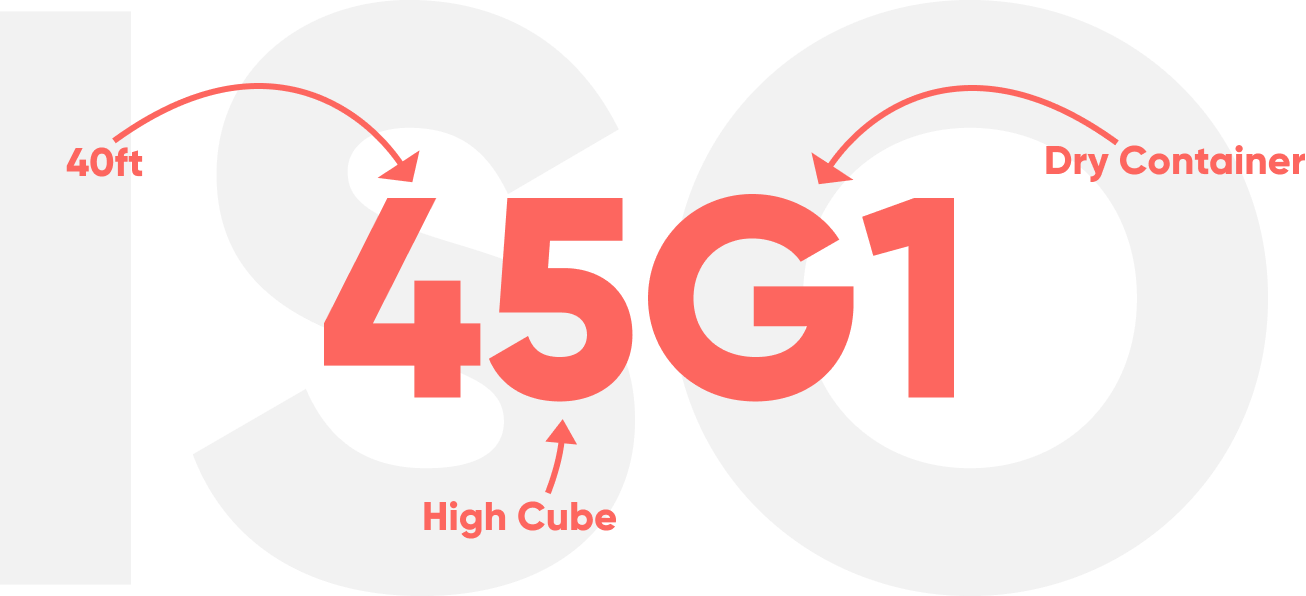Identifying a container size and type with four symbols? Easy. So today we'll talk about the container identification process. Actually prepared useful guidelines. Keep reading. Let's look at the example container:

How's the container made? Doors, handles, walls, ventilation etc. Let's check it in detail. We added some graphics right on the photo:

The image can be zoomed in.
Very simple and secure construction. What about its marking? What are these numbers and letters on a shipping container?

The image can be zoomed in.
Okay, saw it. Now get ready for some text. Sorry, but this information is very important.
Container Identification System
You've seen it already above. Identification is about the prefix (owner code), the serial number and the check digit. This system ensures the unified international identification of containers and documentation related to container transportation from door to door. Closer it looks like this:

Yet closer:

Owner code/Prefix – three capital letters of the Latin alphabet to identify the owner or the main operator of the container.
Equipment category identifier – one capital letter:
Check digit is one Arabic digit that ensures verification of the accuracy of recording and transmission of the owner code and the serial number.
Equipment category identifier – one capital letter:
- U for all freight containers,
- J for removable freight container-related equipment,
- Z for trails and chassis.
Check digit is one Arabic digit that ensures verification of the accuracy of recording and transmission of the owner code and the serial number.
Should we find the owner of our container?
To do so, let's visit the website of Bureau International des Containers et du Transport Intermodal (BIC) which with the use of the world network of registration companies gives the owner code to each container owner or operating company: https://www.bic-code.org/bic-codes/

The search shows the container belongs to Flex Box, which is, by the way, an active user of our platform. Results:
Video instruction:
Moving on. The owner said that the container we are currently checking was a standard 20' dry shipping container. We could trust that, but let's double check. Where to look at?
Container size and type codes
In 1995, the ISO agreement was made and it dealt with the codes to denote container length, height and type in a definite sequence. This sequence consists of four letters or digits that are usually placed close to the container identification system.

- The first symbol is related to container length – 2
- The second symbol is related to its height – 2
- Two remaining symbols of the sequence identify container type and characteristics – G1
The owner didn't lie: 22G1 is literally a 20' general purpose dry shipping container, where 2 is its length (20'), second symbol 2 is its height (8'6'') and width 2436 mm (standard size), and two remaining symbols G1 define its type - dry cube/dry container.
All these sizes and types are standardized in the aforementioned ISO. We simply find necessary symbols in a ready-made ISO 6346:1995/Amd 3:2012 or check them online on the very same website of BIC: https://www.bic-code.org/size-and-type-code/
All these sizes and types are standardized in the aforementioned ISO. We simply find necessary symbols in a ready-made ISO 6346:1995/Amd 3:2012 or check them online on the very same website of BIC: https://www.bic-code.org/size-and-type-code/
Video instruction:
ISO table
ISO 6346:1995/Amd 3:2012 contains over 20 pages. Three of them are tables necessary for fast determination of container type and size. We've extracted these tables to our own online document here:
Open, add and use for your benefit! The document is always up-to-date, as we follow all the changes of ISO.
Container plates and stickers
This plate is found on all containers involved in international cargo transportation, apart from those specially assigned for air transportation. Marking key provisions are adopted by the Convention for Safe Containers (CSC). Plates, issued by a qualified supervisory body of a country that signed this agreement, certify a container to be safe for international freight transportation in countries which signed CSC.
Safety plate is attached to the lower part of the container's left door. It provides the following data: a certification country, an issue data, a container number assigned by the factory and other technical characteristics.
Safety plate is attached to the lower part of the container's left door. It provides the following data: a certification country, an issue data, a container number assigned by the factory and other technical characteristics.

CSC plate
At the top of the plate you can also find information on container admission for transportation with customs stamps and seals (Approved For Transport Under Customs Seal). The plate confirms container compliance with container-related requirements of the TIR Convention, and it is compulsory for international container transportation.
Apart from the main marking, containers also have special signs with technical characteristics. Placed to share information or virtual warning, they are not related to the aforementioned codes. There are mandatory and optional operational marks.
Mandatory ones include markings with maximum gross and tare weight. It is necessary to state weight in both kilos and pounds.
Mandatory ones include markings with maximum gross and tare weight. It is necessary to state weight in both kilos and pounds.

Carrying and holding capacities
All ISO containers must be checked and certified with accordance to the international regulations.
Lloyd's Register certification assumes that a container is checked and certified before its commissioning. Moreover, it will be checked again in five years, and then it will go through a check-up approximately every two years.
Lloyd's Register certification assumes that a container is checked and certified before its commissioning. Moreover, it will be checked again in five years, and then it will go through a check-up approximately every two years.

LR Certificate
It is an international rail transportation security certificate. The number after «iC» defines a concrete railway certification. Often found:
iC61 – Korean national railway
iC70 – Railway of Great Britain
iC80 – Deutsche Bahn (German railway)
iC81 – Austrian federal railway
iC87 – SNCF (French railway)
iC61 – Korean national railway
iC70 – Railway of Great Britain
iC80 – Deutsche Bahn (German railway)
iC81 – Austrian federal railway
iC87 – SNCF (French railway)

interContainer certificate
"Attention. This container must be repaired only with corten steel" speaks for itself, only high-strength steel can be applied for fixing a container.
It's said that Corten-branded steel was made in the USA and it's utilized for constructing American submarines. This steel is not subject to corrosion.
It's said that Corten-branded steel was made in the USA and it's utilized for constructing American submarines. This steel is not subject to corrosion.

Warning information
All air- and land-type containers must have a special plate.The symbol must be placed at the left top corner of the container's back doors, its side walls and a roof. If a plate is fused with the container's color, it is necessary to place it on a suitably-colored (preferably white) panel.

Other
All containers, equipped with side ladders, must have a warning sign of overhead electrical danger. It must be located close to container ladders.

All containers higher than 2.6 m must have the following mandatory signs:
- Height sign on both sides of a container. The upper set of digits states container height in meters up to a decimal, but not less than the actual height. The lower set of digits shall give the height in feet, and it can not be less than the actual height. To save space, the symbols ' and " are utilized instead of ft and in, feet and inches respectively.
- The interchange black and yellow stripes shall be placed at the top elements of each back frame and side walls adjacent to the corner fitting.


Today we've learnt about the labeling; and hopefully ISO codes are now a piece of cake to you. However, that's not all we'd like to say. More material will be added over time. If you like the article, please share it on social media:
Related






